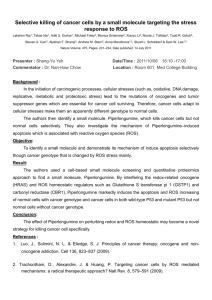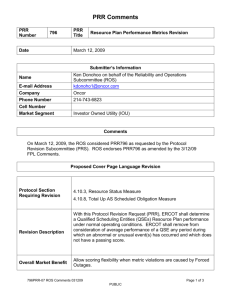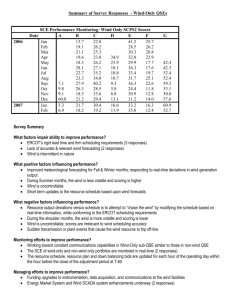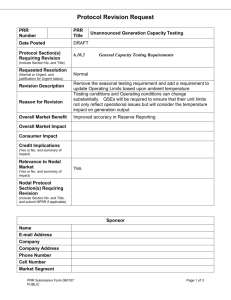08. ROS Action Plan for Follow-Up on Feb 26 EECP
advertisement
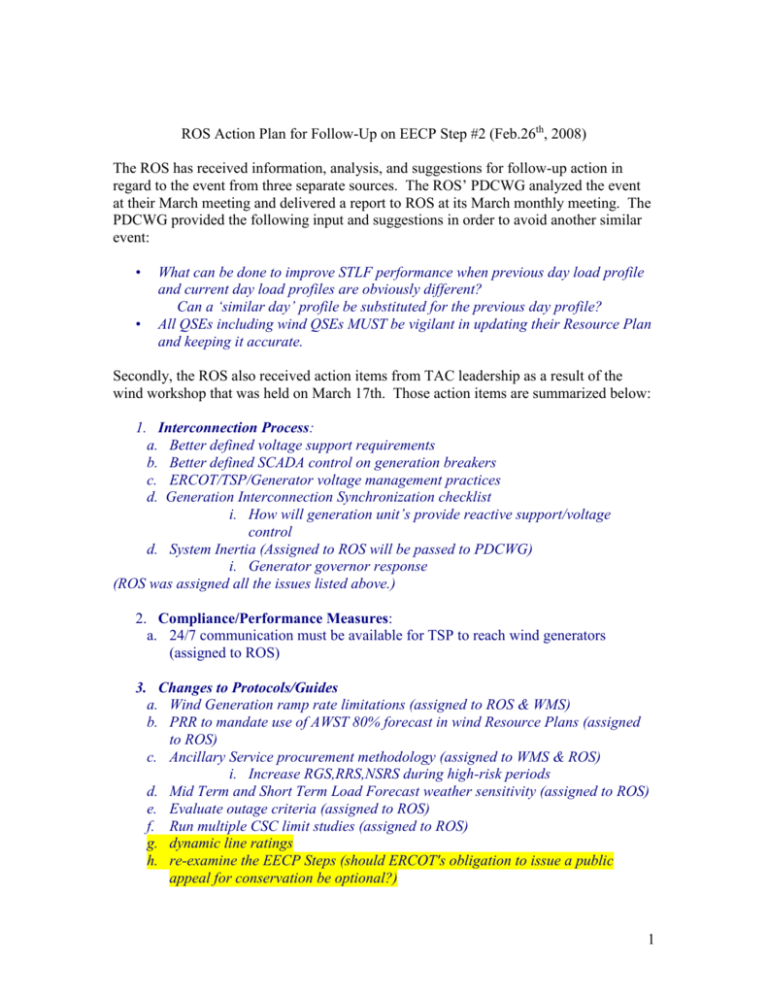
ROS Action Plan for Follow-Up on EECP Step #2 (Feb.26th, 2008) The ROS has received information, analysis, and suggestions for follow-up action in regard to the event from three separate sources. The ROS’ PDCWG analyzed the event at their March meeting and delivered a report to ROS at its March monthly meeting. The PDCWG provided the following input and suggestions in order to avoid another similar event: • • What can be done to improve STLF performance when previous day load profile and current day load profiles are obviously different? Can a ‘similar day’ profile be substituted for the previous day profile? All QSEs including wind QSEs MUST be vigilant in updating their Resource Plan and keeping it accurate. Secondly, the ROS also received action items from TAC leadership as a result of the wind workshop that was held on March 17th. Those action items are summarized below: 1. Interconnection Process: a. Better defined voltage support requirements b. Better defined SCADA control on generation breakers c. ERCOT/TSP/Generator voltage management practices d. Generation Interconnection Synchronization checklist i. How will generation unit’s provide reactive support/voltage control d. System Inertia (Assigned to ROS will be passed to PDCWG) i. Generator governor response (ROS was assigned all the issues listed above.) 2. Compliance/Performance Measures: a. 24/7 communication must be available for TSP to reach wind generators (assigned to ROS) 3. Changes to Protocols/Guides a. Wind Generation ramp rate limitations (assigned to ROS & WMS) b. PRR to mandate use of AWST 80% forecast in wind Resource Plans (assigned to ROS) c. Ancillary Service procurement methodology (assigned to WMS & ROS) i. Increase RGS,RRS,NSRS during high-risk periods d. Mid Term and Short Term Load Forecast weather sensitivity (assigned to ROS) e. Evaluate outage criteria (assigned to ROS) f. Run multiple CSC limit studies (assigned to ROS) g. dynamic line ratings h. re-examine the EECP Steps (should ERCOT's obligation to issue a public appeal for conservation be optional?) 1 4. Training a. Wind generator knowledge of plant equipment/controls/best practices Finally, ROS received from the TRE on April 11th a set of observations and suggestions solicited from stakeholders as an action item from the March 13th ROS meeting. Those observations and suggestions were: Suggested Brainstorming Areas for TRE/ROS Consideration EECP Step#2 Event/2-26-2008 First, we consider the event primarily the product of two factors, 1) poor wind production forecasting, and 2) a failure to correctly judge the imminent impact of the upcoming evening load ramp due to a frontal passage, in combination with the wind’s production drop off. Wind forecasting and load forecasting problems were also accompanied by a handful of QSEs who were off schedule and one non-wind asset (150 MWs) tripping, both variables that absent the frontal passage and wind mis-forecast would have represented minimal impact to the system’s reliability and certainly would not have forced the ISO to move to EECP Step #2. Event-Driven Considerations: 1) Procure blocks of NSRS on a day-ahead basis to cover only certain hours of forecasted major weather frontal passage (PRR may be required for adjustment in criteria for procurement), 2) ERCOT should hire an experienced energy market meteorologist to work on daily wind and load forecasting and to be on call for weekend weather events, 3) Begin modifying the handling of the day-ahead and the short-term load forecasting process by building an hourly load and weather database and using days other than yesterday to forecast tomorrow. Using yesterday to forecast tomorrow works pretty well during the middle of Peak Season when the skies are clear and the temps are forecasted at 90/70, but during shoulder months, particularly the Spring “kite flying days” when huge variations in weather are driven by frontal passages, using yesterday to forecast tomorrow can be a recipe for disaster. ERCOT Operations should be free to fit new load curves to what’s happening in a particular day using frontal passage data from similar weekday, month, non-holiday periods from a database of historical data. Steady State Operation Considerations: 2 4) Leave “Wind-Only QSE” Category in place: Set a realistic SCPS metric for wind only QSEs in the range of 50-60 percent and incorporate them in the same direct assignment/payment process as other technologies have for SCE performance, 5) Delete the “Wind-Only QSE Category: all wind generation facilities should be part of a QSE that has a CPS metric assigned to it. This will force that QSE to control to the uncontrollable wind generators and allow poor performance characteristics of wind to be monetized by the market under PRR 525. Instead of enforcing the “death penalty” on those QSEs for ancillary service provision we might discuss how to enforce performance with a larger penalty structure than the one provided in PRR 525. 6) Without “Wind-Only QSEs”, we could establish a methodology for WGRs to purchase supplemental regulation service from another QSE through the existing Responsibility Transfer provision already in the Protocols. An example of this method might use a minimum transfer with the possibility of a dead band such as: Given 100 MW of wind energy committed to ERCOT Only 25 MW of wind energy being delivered Results: Wind QSE received 37.5 MW of energy via a RT (dynamic energy xfer) from another QSE (obviously a non-wind QSE). Wind QSE draws 37.5 MW of regulation energy from ERCOT. 100 MW of expected MW are delivered to the grid. Most of the MW are delivered in locations that are grid friendly (some concerns potentially over cross zonal boundary transfers since most wind is in West Zone), ERCOT was only on the hook for half of the wind QSE imbalance (50 MWs) In the end, this creates a market based manner for wind QSEs to firm up their obligations. 7) set wheels in motion to study what amount of machine inertia or substitutable response is needed for the various amounts of wind penetration and begin a discussion of how we manage unit commitment in zonal and nodal to achieve the minimum, (note: wind-only QSE control performance characteristics, even though they do not have metrics applied to them, do impact the overall ERCOT NERC CPS1 score.), 8) Explore the concept of requiring storage companion capabilities (i.e., similar to pumped hydro) for any new wind beyond the legislative RPS level. 9) Establish a prescribed ramp rate for wind farms ramping up production after completion of an OOM-E Down instruction in order to apply controls to the near term frequency oscillations seen in the system. 3 ROS’ plan for dealing with the action items and suggestions is to form a task force with a very specific scoping that includes, 1) identifying beneficial suggestions that they can write PRRs for the Zonal Market’s remaining timeline that are timely and not budget constrained, 2) identify NPRRs that can be introduced and approved without threatening the Nodal Implementation Go-Live date from either a budgetary or timeline aspect, 3) identify policy and procedural items that can be implemented immediately that will be beneficial to ERCOT Operations’ management of wind capacity and forecasting. MOTION: ROS approves this action plan for carrying out the follow-up assignment assigned to it by TAC leadership in regard to the 2/26/2009 EECP Event. 4


